The pandemic has altered just about every facet of the resort ski experience—minus powder turns. From purchasing lift tickets in advance to physical distancing in lift lines to outdoor and distanced après-ski, skiing in the time of COVID requires patience, flexibility and responsibility. But, the sentiment felt strongest around Jackson Hole Mountain Resort—and most resorts around the West—is gratitude. Most of us are willing to do our part to keep the lifts spinning and ski areas operating safely.
The most important health and safety measure required of skiers and snowboarders at JHMR is also one of the easiest to follow: wear a multi-layer face covering over your nose and mouth at all times in all indoor and outdoor public areas, including lift lines, loading areas and on chairlifts. It’s science. Facemasks prevent the spread of COVID-19 by reducing the size and amount of droplets put in the air and reducing how fast and far droplets travel.
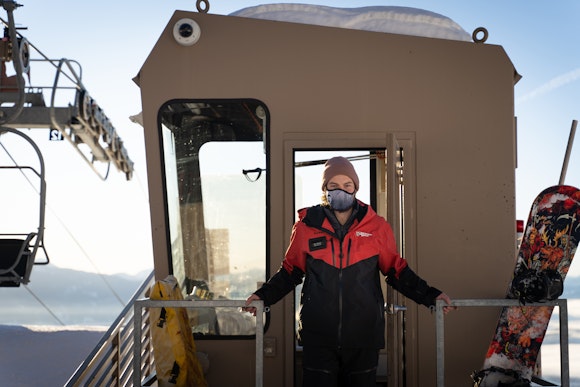
A JHMR employee masked up and ready for a day of work
“Even though you’re outside, people need to realize there is always a risk,” says Rachael Wheeler, Public Health Response Coordinator for Teton County Health Department. “We all want to keep the mountain open. We all need to take accountability and protect everybody.”
As many of us now know, infectious aerosol particles can be released during breathing and speaking by asymptomatic infected individuals. No masking maximizes exposure, whereas universal masking results in the least exposure.
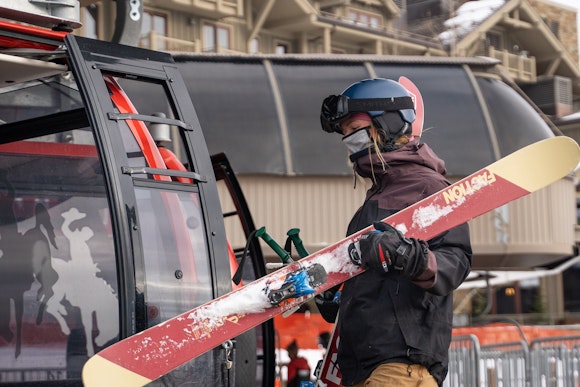
Mask up, Ride on.
Teton District Health Officer Dr. Travis Riddell—an avid skier—says if we space out and keep our masks on, skiing can be a safe COVID-era activity. But, he says, protecting others is key. “When you are in a crowded lift line with hundreds of people, it’s the time to be thoughtful about preventing the spread of COVID to others. There’s enough asymptomatic and pre-symptomatic COVID out there, that wearing a proper mask is really a social responsibility.”
But as you may have noticed, the face coverings in the lift line vary as much as a skier’s line down the Hobacks. You’ve likely seen everything from bandannas to N95 respirators with exhalation valves (neither provide adequate protection), but masking up really only works when done the right way. Would you take your 80mm waisted all-mountain skis out on a 22-inch powder day? Especially when it comes to pandemic protection, it’s critical to pick the right tool for the job.
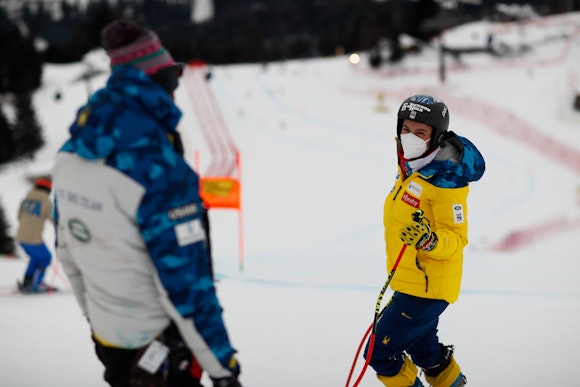
Athlete Breezy Johnson staying safe while on course for the US Ski Team
“Research has shown that buffs, even folded over, are not a COVID-safe mask,” says Wheeler. “Wear your best mask. It needs to be tight fitting over your nose and mouth. We recommend multi-layer, non-woven fabric masks or surgical masks.”
So, just to recap: single-layer woven fabrics don’t cut it. If you’re wearing a buff, scarf, bandanna, or neoprene face mask with ventilation, you need to pair it with a proper multi-layer mask.
And says Wheeler: “Bring extra masks for when it gets wet—wet masks are ineffective.”
JHMR athlete Veronica Belle Paulsen—who landed a backflip in Corbet’s Couloir last year—wears a regular cloth mask with ear loops with a buff layered on top. “My pockets are chock full of masks—when they get wet, they aren’t doing their job.”
JHMR athletes like Caite Zeliff and Lynsey Dyer wear an AVALON7 Fitmask, designed by fellow JHMR athlete Rob Kingwill, usually in conjunction with a necktube and/or balaclava. They appreciate the highly adjustable Lycra earloops, three layers of quick drying fabric, a 3D pattern that fits snugly around the face, a metal nose bridge and a filter pocket to add extra protection.
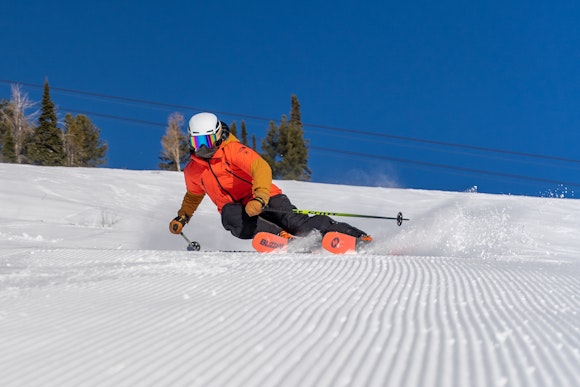
Caite Zeliff masked up and enjoying The Grand
Dyer, an artist and skier, designed a Unicorn Picnic colab Fitmask featuring sparkles and unicorns. “It’s just created well,” says Dyer of the Fitmask. “It fits perfectly and helps me feel responsible. It’s always a privilege to ski, but especially this season. Every day feels like a gift.”
Kingwill produced 1,600 masks for JHMR staff and lift operations, and used feedback from JHMR snowboard instructors to design a new hinge system that helps attach the Fitmask ear loops to the outside of a helmet.
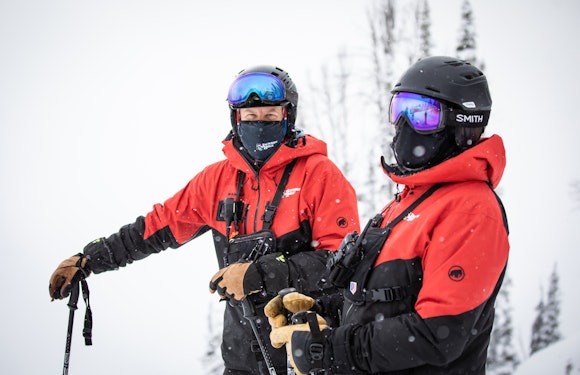
Two JHMR Host wearing an AVALON 7 Fitmask by Rob Kingwill
“It stays up, keeps me warm, and I can breathe,” says Zeliff. “When I ski, I pull it down and use my buff, and in line, I pull it back up.” Zeliff says that it’s all about finding little tips and tricks to ease new transitions. “Skiing is athletic, and I often find myself coming into the lift line huffing and puffing. So, instead of skiing right into the corral, I go off by myself, and make sure my mask is secured properly. I’m of a healthy demographic, but I want to make sure everyone feels safe. It’s important for locals to lead the charge, so visitors follow suit.”
JHMR provides three-layer surgical masks for guest use, but the resort encourages guests to come prepared with proper face coverings.
Incoming visitors should prepare ahead of time, says Wheeler. “Figure out your layering system at home, before you arrive.” And, she says, bring lots of masks.
It’s the least we can do to protect others, protect ourselves and protect our ski season.